What is the triangle and 2 defense in basketball
The triangle and 2 defense is a basketball defensive strategy and a type of junk defense which seeks to limit scoring opportunities, primarily for the opposing team’s two best perimeter players, by implementing a combination of man to man and zone defense concepts.
What is the basic objective of the triangle and 2 defense
Essentially, the basic objective of the triangle and 2 defense is for the defensive team to use their best two perimeter defenders to disrupt or neutralize the scoring and/or playmaking abilities of the offensive team’s best two perimeter players, particularly with man to man pressure defense.
Furthermore, at the same time, the additional three defenders play a zone defense in the form of a triangle, hence the name of triangle and 2.
Moreover, the top zone defender will primarily cover the top and the wings while the bottom zone defenders will typically cover the low post areas, the basket, or the corners.
What is an advantage of the triangle and 2 defense
One notable advantage of the triangle and 2 defense is that it could be useful against offensive teams that rely on getting their scoring options from perimeter players but at the same time, those opposing teams have low post players with below average scoring abilities.
What is a disadvantage of the triangle and 2 defense
One particular disadvantage of the triangle and 2 defense is that it is not as useful against offensive teams that prefer to get the bulk of their scoring from one or more low post players.
Essentially, in the triangle and 2 defense, the main purpose of the bottom zone defenders is to provide support for the two best perimeter defenders as opposed to defending against highly skilled low post players in 1v1 situations.
Therefore, if the offensive team prefers to play through their low post players, the defensive team might be better suited implementing a fully-fledged zone defense or perhaps, just a standard man to man defense.
Who are the chasers and targets in the triangle and 2 defense
In the triangle and 2 defense, the chasers are the defensive team’s two best defenders while the targets are the offensive team’s primary and secondary scorers.
Essentially, the chasers will execute man to man defensive principles against the chasers to limit or prevent scoring opportunities of the offensive team as a whole.
Additionally, it should be noted that it would be more convenient and helpful if the two chasers were not the defensive team’s best scorers when they received the ball on offense.
The reason for that is because the two chasers could potentially use much energy guarding the opposing team’s two best players.
This, in turn, could lead to offensive fatigue, which could hamper the two chasers’ abilities to score effectively and efficiently.
Moreover, it is recommended that the defensive team’s point guard, shooting guard, or small forward be designated as the chasers most of the time.
However, one of the chasers could also be a power forward if that defender is mobile enough to move on the perimeter consistently.
Utilizing a power forward as a potential chaser could be viable because those particular defenders usually have longer arms than the smaller point guard, shooting guard, or small forward basketball positions.
This could possibly make it easier to contest field goal attempts taken by one of the two targets. Furthermore, if the defensive team has two or more above average defenders, then the coaching staff could switch out chasers periodically.
If that occurs, it could potentially frustrate the two targets because then, the targets would have to adapt to new defenders in an effort to get open and score the ball.
Who is the third best shooter in the triangle and 2 defense
In terms of the triangle and 2 defense, the third best shooter is a third perimeter player that could provide additional scoring when one or both of the main two targets are not able to score for the offensive team.
Also, the third best shooter usually has the ability to make an average amount of perimeter shots when left open. However, at the same time, this player does not shoot as well as the main two scorers, especially when those shots are contested.
Therefore, the third best shooter typically scores in single digit numbers as opposed to the possible double digit numbers of the primary and secondary scorers.
However, it should also be noted that an offensive team may not truly possess a third best shooter and could literally rely on one or two perimeter scoring threats exclusively.
In a situation such as that, the offensive team’s third leading scorer would be considered a non-shooter, especially if that player has a below average ability to shoot perimeter jump shots.
Who are the non-shooters in the triangle and 2 defense
In the triangle and 2 defense, the non-shooters are usually the offensive team’s post players or perimeter players that cannot shoot, particularly from mid-range or three-point range.
Triangle and 2 defenders should typically give these offensive players enough space to encourage perimeter jump shots.
What are the common defensive actions against the targets within the triangle and 2 defense
The common defensive actions against the targets would mainly depend on if one of those targets already has possession of the ball or if one (or both) of the targets do not have it while being one or more passes away from the ball.
Also, if a target has the ball but the chaser is out of the play because of an action such as getting caught on a basketball screen, then the nearest zone defender can provide temporary on-ball pressure if necessary.
Afterwards, the chaser can get back into the play and bump that zone defender back to their original area near the top or low post blocks.
If the target is one pass away from the ball
If the target is one pass away from the ball, then the chaser will execute a hard denial defense to keep the target from receiving the ball.
By executing a hard denial in which the chaser turns their entire backside towards the ball, this encourages the target to execute the backdoor cut as a counter option.
In standard man to man defense, getting beat by the backdoor cut would be bad news for the denying defender and the defensive team as a whole because it would essentially force an off-ball defender to give help defense, particularly at the basket.
However, in the triangle and 2 defense, the backdoor cut is more or less encouraged because there should already be two bottom zone defenders near the basket ready to give support until the chaser is able to recover.
In addition to that, in some instances, the chaser or one of the zone defenders might be able to intercept the pass to the target as the backdoor cut happens which leads to a live-ball turnover and a possible scoring option via the primary break.
If the target is more than one pass away from the ball
If the target is more than one pass away, then the chaser has the option to continuously deny the pass or step away from the target towards the mid-post area near the lane line.
Also, if the target is more than one pass away and the target executes a baseline run to the same side of the ball, then the chaser should stay on the high side of the target to the ball side of the floor.
In other words, the chaser should never get below the target or even follow directly behind the target when that same target is attempting to get open.
If the chaser gets below or follows behind the target, this will give the target an opportunity to receive the ball and possibly score near the rim or from the perimeter.
If the target has the ball at the top
If the target has the ball at the top, then the chaser should guard the target with the proper defensive stance and attempt to keep the target away from the lane at all times without fouling.
Also, if the third best shooter is on the wing, then the top defender should cover the high post area on that same side to be ready to closeout if necessary while discouraging dribble penetration towards the basket by the target at the top.
Furthermore, if there is a non-shooter on the wing, then the top zone defender could guard stand near the center of the free throw line, which is the nail, or get slightly below that same area in the lane to provide additional help if the target attempts to get dribble penetration towards the basket.
Additionally, if necessary, the bottom zone defenders should front on the inside of low post players to discourage the simple high low pass from the top.
If the target has the ball on the wing
If the target has the ball on the wing, then the chaser should guard the target with the proper defensive stance and attempt to keep the target away from the lane at all times without fouling.
Additionally, the top zone defender should stand near the high post elbow to restrict dribble penetration towards the middle while the bottom zone defenders front the low post if necessary and protect the basket.
If the target has the ball in the corner
If the target has the ball in the corner, then the chaser should guard the target with the proper defensive stance and attempt to keep the target away from the lane at all times without fouling.
Moreover, the top zone defender should stand in the gap between the wing and the corner. This not only discourages middle dribble penetration but the top zone defender is ready to properly closeout if the the third best shooter receives the ball on the wing.
Also, if the other target is two passes away at the top, then the chaser of that target can continue to deny which encourages the backdoor cut into defensive traffic.
However, if the other target is three or more passes away on the opposite wing or corner, then the target of that chaser could slide towards the lane line to give additional help near the basket if necessary.
What are the common defensive actions against the third best shooter within the triangle and 2 defense
The common defensive actions against the third best shooter typically depends on where that player receives the ball on the floor.
If the third best shooter has the ball at the top or wing
If the third best shooter has the ball at the top or on the wing, then the top zone defender will closeout with high hands. The main purpose is to discourage the jump shot and encourage the drive.
However, if the third best shooter attempts to drive to the basket, then the top defender should try to keep that player away from the lane while the top defender stays within their own zone area.
This defensive action could also influence the third best shooter to pass the ball to a non-shooter or perhaps, the third best shooter might settle for a contested jump shot.
Furthermore, the chasers will continue to deny the targets or provide help defense if necessary while the bottom zone defenders continue to front the low post or protect the basket.
If the third best shooter has the ball in the corner
If the third best shooter has the ball in the corner, then the bottom zone defender on that side will attempt to closeout to prevent the uncontested jump shot while encouraging the dribble drive.
Also, the top zone defender could stand near the mid-post between the wing and the corner on that side to restrict dribble penetration towards the middle.
Furthermore, the opposite bottom zone defender will play directly behind the low post player on that side if necessary while one of the chasers, particularly on the opposite side could deny or help.
What are the common defensive actions against the non-shooters within the triangle and 2 defense
The common defensive actions against the non-shooter typically depends on where those players receive the ball on the court.
Also, if a non-shooter receives the ball, then the zone defender guarding them can fake and fade with high hands to cause the non-shooter to become potentially indecisive.
The fake and fade basically means that the defender will execute a fake closeout at the non-shooter with two short, choppy steps (or a small two-footed hop) and then fade back with two additional short, choppy steps (or a small two-footed hop).
If a non-shooter has the ball at the top
If a non-shooter receives the ball at the top, then the top zone defender will drop back to the center of the free throw line (i.e the nail) to cut off the easy drive to the lane while encouraging the jump shot.
The bottom zone defenders will continue to front the low post if necessary or protect the basket while the chasers continue to deny or help.
If a non-shooter has the ball on the wing
If the non-shooter receives the ball on the wing, then the top zone defender will drop back to the high post elbow area to discourage the drive, particularly towards the middle.
Also, if the non-shooter catches the ball via ball reversal, then the bottom zone defender on that side could temporarily step up with the fake and fade until the top zone defender bumps the bottom zone defender back to the original area.
As that occurs, the other bottom zone defender can protect the basket or defend the low post on that side while the chasers continue to deny or help.
If a non-shooter has the ball in the corner
If a non-shooter receives the ball in the corner, then the bottom zone defender on that side of the court can fake and fade with high hands.
At the same time, the top zone defender could stand in the gap between the corner and wing ready to closeout on the third best shooter if necessary.
Moreover, the opposite bottom zone defender could defend behind the ball side low post player if necessary.
Also, if one of the targets is three passes away, then the chaser of that target has the option to provide help from the weak side.
Affiliate Disclosure: I may earn a commission on qualifying purchases made through the links below.
What are simple diagram examples of the triangle and 2 defense
For each of the triangle and 2 defense examples below, 1 and 2 are designated as the offensive team’s primary and secondary scorers and are therefore, the main targets.
3 is the offensive team’s third best shooter while 4 and 5 are the offensive team’s non-shooters.
In terms of the defensive team, X1 and X2 are the chasers, X3 is the top zone defender while X4 and X5 are the bottom zone defenders.
Furthermore, the examples below as well as the information above are derived from The Complete Guide to the Triangle and Two Defense by Rick Majerus.
Example 1
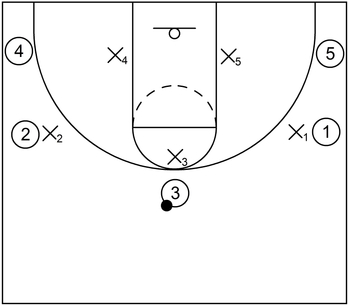
This is an example of the triangle and 2 defense when the third best shooter receives the ball at the top. Also, for this particular situation, the offensive team uses a 5 out formation for demonstrative purposes.
When that occurs, X3 closes out to the ball with high hands while X4 and X5 stay near the low post blocks. Moreover, X1 and X2 deny the ball to the targets.
Example 2
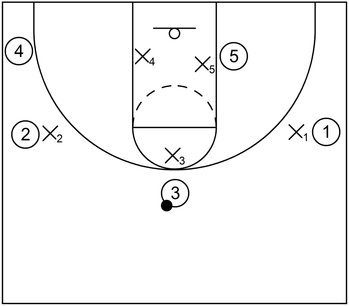
This is an example of the triangle and 2 defense when the third best shooter has the ball at the top. However, this time, the offensive team has at least one low post non-shooter near the basket.
When that happens, X3 executes a closeout to prevent the uncontested jump shot while X1 and X2 deny one pass away.
X5 can front 5 on the inside to discourage the high low action. Furthermore, X4 can step into the lane to give support if necessary because 4 is a non-shooter in the left corner.
Example 3
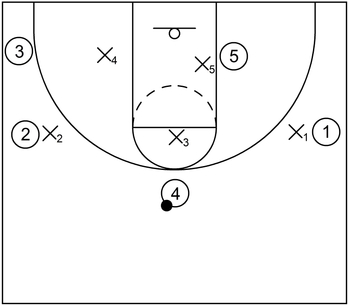
This is an example of the triangle and 2 defense when a non-shooter receives the ball at the top. When that occurs, X3 sags off near the nail to discourage the drive while giving up the potential jump shot.
The chasers continue to deny one pass away while X5 continues to front near the basket. Also, for this situation, X4 can stay near the left side low post area ready to closeout on the third best shooter in the event of a possible skip pass from 4.
Example 4
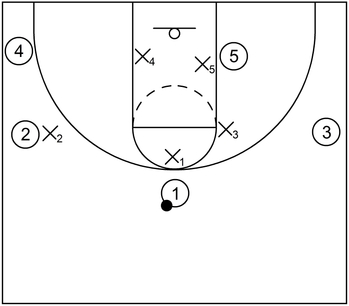
This is an example of the triangle and 2 defense when a target has the ball at the top. When that occurs, the chaser guarding that target (for this case, X1) implements on-ball defensive pressure to discourage the jump shot.
Moreover, for this situation, the third best shooter is one pass away. So, when that occurs, the top zone defender can stand in the gap between the top and the wing near the high post elbow.
This allows the top zone defender to help on the dribble penetration, particularly towards the right side of the lane if necessary. However, the top zone defender can closeout to the third best shooter (in this case, player 3) as well.
X2 continues to deny while X5 continues to front. Additionally, X4 can give extra protection at the basket because 4 is a non-shooter in the left corner.
Example 5
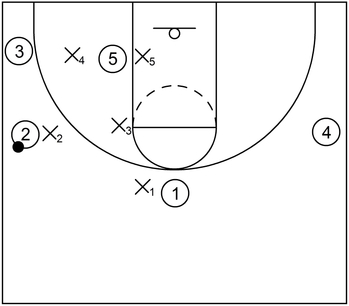
This is an example of the triangle and 2 defense when a target receives the ball on the wing. When that occurs, the chaser of that target (for this case, X2) executes on-ball pressure to discourage the jump shot.
Also, the top zone defender, X3 can fill the left side high post elbow to discourage middle dribble penetration.
The other chaser, X1 can continue to deny because the ball is one pass away. Furthermore, the third best shooter is also one pass away so the bottom zone defender can stand in the gap between the ball side low post and the corner, ready to closeout if necessary.
The opposite bottom zone defender, X5 plays behind 5 as opposed to fronting in this instance. Also, for this example, 4 is a non-shooter and receives no concern.
However, if 4 receives a skip pass or attempts to cut to the basket, then the zone defenders would have to rotate accordingly.
Example 6
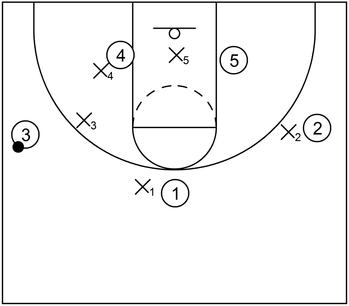
This is an example of the triangle and 2 defense when the third best shooter receives the ball near the wing. When that occurs, X3 closes out to the ball but typically stays inside the three-point line.
Also, the chasers can continuously deny to influence the backdoor cut action. Moreover, both of the non-shooters are near the low post blocks. So, X4 can front the low post on the ball side while X5 slides into the lane to protect the basket.
Example 7
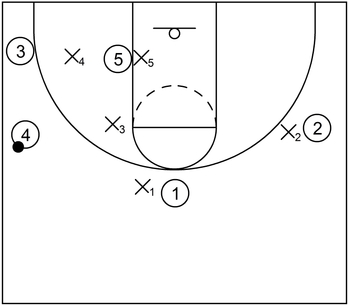
This is an example of the triangle and 2 defense when a non-shooter has the ball on the wing. When that happens, X3 can sag off near the left side high post elbow to encourage the jump shot and restrict the dribble drive.
Also, the third best shooter is one pass away in the left side corner so X4 can stand in the gap between the corner and low post. Furthermore, X5 can play behind 5 while X1 and X2 continue to deny.
Example 8
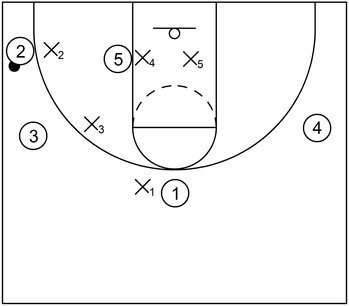
This is an example of the triangle and 2 defense when a target catches the ball in the corner. Once that occurs, the chaser of that target (in this case, X2) pressures the ball with high hands to discourage the jump shot.
Also, the third best shooter is one pass away so the top zone defender can stand in the gap between the wing and corner near the free throw line extended. This allows the top zone defender the ability to closeout if the third best shooter were to receive the ball.
Moreover, X4 can play directly behind 5 on the same side of the ball while X5 protects the basket and watches for any weak side cutting action by 4.
Example 9
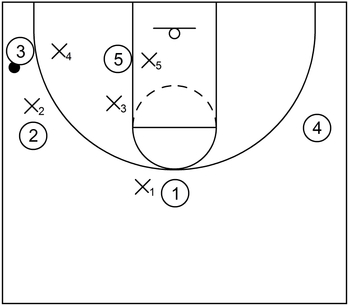
This is an example of the triangle and 2 defense when the third best shooter catches the ball in the corner. When that happens, the bottom zone defender on that side (X4 in this situation) can closeout to the ball with high hands.
Also, the top zone defender can stand near the mid-post on the same side of the ball to help restrict dribble penetration towards the middle of the lane while X5 plays directly behind 5.
The chasers can continue to deny the ball to the targets and the zone defenders could also rotate accordingly if 4 receives the ball via a skip pass from the corner.
Example 10
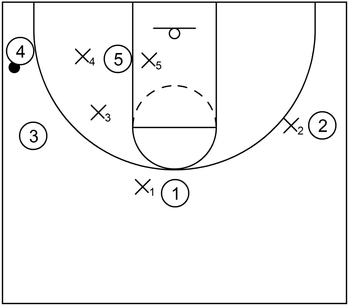
This is an example of the triangle and 2 defense when a non-shooter receives the ball in the corner. When that occurs, X4 can sag off with a fake and fade to encourage the jump shot.
Moreover, the third best shooter is one pass away on the left side wing so X3 can stand in the gap between the corner and wing to discourage the middle drive while also being ready to closeout on 3 if necessary.
As that happens, X5 plays directly behind 5 on the same side of the ball while X1 and X2 continue to deny the targets.
What are additional basketball defensive strategies that are comparable to the triangle and 2 defense
The box and 1 defense is a basketball defensive strategy and a type of junk defense which seeks to limit scoring opportunities, especially for the opposing team’s best player, by implementing a combination of man to man and zone defense principles.
The diamond and 1 defense is a basketball defensive strategy, a type of junk defense, and a variation of the box and 1 defense which seeks to limit scoring opportunities, particularly for the opposing team’s best player, by implementing a combination of man to man and zone defense principles.